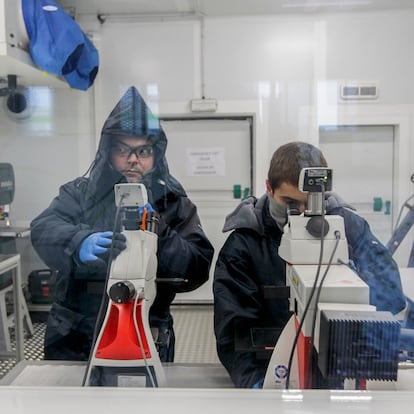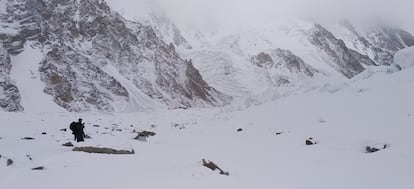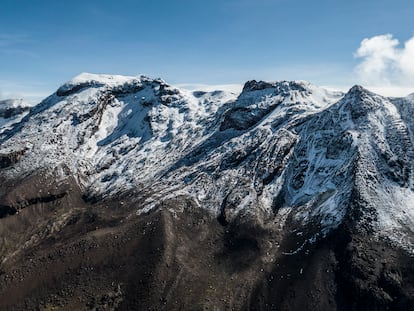The Spanish laboratory that studies ice bubbles where centuries-old atmosphere is trapped
The only ice lab in the country, where researchers work at temperatures of up to -22ºF, studies samples from around the world to understand the impact of climate change

Nicolás González could not have imagined trudging along in the middle of February and in a blizzard at -13ºF (-25ºC). To his consolation, he was not alone. He was accompanied by two porters carrying 55 pounds of scientific equipment, although the group was led by the Basque mountaineer Alex Txikon. They were all on their way to the K2 base camp in the Karakorum range in Pakistan, a few miles from the Chinese border. The 30-year-old’s mission, however, was not to reach the summit, but to take samples of snow from one of its glaciers, the Baltoro, which is around 37 miles (60 km) long. If all went well, he would be closer to becoming a doctor of geology at the University of the Basque Country in northern Spain.
“During our expedition in the winter of 2019, precipitation in the area was the heaviest in the last half century,” recalls González. Despite several unforeseen events, the samples were extracted and the research developed. He explains that his objective was to analyze how the black carbon that settled on the seasonal mantle affected the snow.
All those parts of the planet that contain permanent ice are of interest to the research of this group, which is focused on the cryosphere (the parts of the Earth’s surface where water is in a solid state). González has also analyzed the ice of the Monte Perdido glacier in the Pyrenees — whose disappearance is now inevitable — and is currently participating in a study based on a “surface” ice core from Greenland, extracted at a depth of nearly 400 feet (120 m), as part of the EastGRIP project.
It is doing so from a pioneering laboratory in Spain, located at the BC3 climate change research center in Leioa, in Spain’s northern Basque region. The facility has been named Izotzalab (izotz means “ice” in Basque). In it, up to six researchers work with ice from different parts of the planet in conditions similar to those that would be encountered in those places. “From these buttons,” says Patricia Muñoz, a research technician, “I can regulate the air humidity and temperature. We usually work at between -20ºC (-4ºF) and -30ºC (-22ºF). There are always two of us working here. On some occasions, both of us are inside; on others, one of us is in this room, from where we monitor the interior,” she explains.
The team’s daily work is governed by the existing legislation for cold storage: for example, they have to take breaks every hour. Before they enter the room, they put on special protective clothing and acclimatize for a few minutes in an antechamber.
The ice is stored in plastic bags distributed between two boxes that reach temperatures as low as -112ºF (-80ºC). From the cylinder-shaped crude, a sample is cut and polished for analysis. In total, they keep about 1320 pounds (600 kg) or, in other words, enough material for “several years” of work. “It is impossible to put a monetary value on the ice we have stored,” Muñoz confesses. However, it is clear to her that the processes for its extraction have involved expeditions costing millions of dollars.
Sérgio Henrique Faria is the scientist in charge of Izotzalab. He receives EL PAÍS in his office full of expedition photographs, where he waits for a project that require new samples from a particular site. The Brazilian-born scientist stresses the importance of the information contained in the ice: “When snow is deposited, it captures all the atmospheric chemistry. When it accumulates, as its structure is granular, hollows are formed which, with the weight of the layer itself, become isolated bubbles.” As such, they retain the exact air composition at the moment of compaction.
For example, research carried out in Antarctica managed to analyze what the atmosphere was like 800,000 years ago. “Now, there is a race to see which country gets ice from more than a million years ago,” says Faria.

The group studying the Greenland samples has managed to reach 130,000 years. It is made up of Spanish and Japanese researchers, among others. “Japan is in charge of the air and temperature analysis, while we focus on the physical-mechanical analysis,” summarizes the laboratory manager. In this project, the task of Faria’s team is “to understand how the snow has been compacted and transformed into ice so that the models, both of ice flow and climate records, can be correctly interpreted.”
González adds that, by seeing how snow is transformed into ice, they gain more precise knowledge: “We can refine our knowledge about the process of encapsulation of these pieces of atmosphere. A lot of information is recorded,” he explains.
Six people currently work in the 25-square-meter laboratory. Two are its director and its research technician, while the rest are scientists — who rotate depending on their work schedule — doctoral students, or trainees. Funding comes mainly from the Basque regional government, through an allocation for BC3, but also from the national government of Spain. When asked about the cost of the laboratory, those in charge say they do not know.
The melting of glaciers in Alaska, the Himalayas, the Andes, or the Alps affects the water security of the communities that depend on their rivers. As for the two poles, the concern centers on rising sea levels. “The disappearance of ice is always connected to the cycle of life, water, or precipitation itself,” says González. “This is why it is a fundamental indicator of the effects of climate change.”
Sign up for our weekly newsletter to get more English-language news coverage from EL PAÍS USA Edition
Tu suscripción se está usando en otro dispositivo
¿Quieres añadir otro usuario a tu suscripción?
Si continúas leyendo en este dispositivo, no se podrá leer en el otro.
FlechaTu suscripción se está usando en otro dispositivo y solo puedes acceder a EL PAÍS desde un dispositivo a la vez.
Si quieres compartir tu cuenta, cambia tu suscripción a la modalidad Premium, así podrás añadir otro usuario. Cada uno accederá con su propia cuenta de email, lo que os permitirá personalizar vuestra experiencia en EL PAÍS.
¿Tienes una suscripción de empresa? Accede aquí para contratar más cuentas.
En el caso de no saber quién está usando tu cuenta, te recomendamos cambiar tu contraseña aquí.
Si decides continuar compartiendo tu cuenta, este mensaje se mostrará en tu dispositivo y en el de la otra persona que está usando tu cuenta de forma indefinida, afectando a tu experiencia de lectura. Puedes consultar aquí los términos y condiciones de la suscripción digital.
More information










































